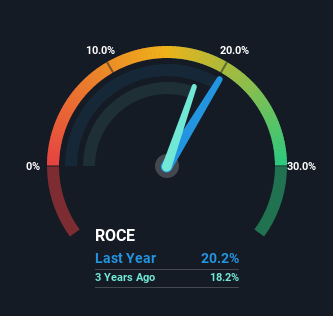- Canada
- /
- Hospitality
- /
- TSX:SRV.UN
We Think SIR Royalty Income Fund (TSE:SRV.UN) Might Have The DNA Of A Multi-Bagger
If you're not sure where to start when looking for the next multi-bagger, there are a few key trends you should keep an eye out for. Ideally, a business will show two trends; firstly a growing return on capital employed (ROCE) and secondly, an increasing amount of capital employed. Put simply, these types of businesses are compounding machines, meaning they are continually reinvesting their earnings at ever-higher rates of return. With that in mind, the ROCE of SIR Royalty Income Fund (TSE:SRV.UN) looks great, so lets see what the trend can tell us.
Return On Capital Employed (ROCE): What is it?
For those that aren't sure what ROCE is, it measures the amount of pre-tax profits a company can generate from the capital employed in its business. To calculate this metric for SIR Royalty Income Fund, this is the formula:
Return on Capital Employed = Earnings Before Interest and Tax (EBIT) ÷ (Total Assets - Current Liabilities)
0.20 = CA$8.8m ÷ (CA$47m - CA$4.1m) (Based on the trailing twelve months to March 2022).
Therefore, SIR Royalty Income Fund has an ROCE of 20%. That's a fantastic return and not only that, it outpaces the average of 8.7% earned by companies in a similar industry.
See our latest analysis for SIR Royalty Income Fund

Historical performance is a great place to start when researching a stock so above you can see the gauge for SIR Royalty Income Fund's ROCE against it's prior returns. If you'd like to look at how SIR Royalty Income Fund has performed in the past in other metrics, you can view this free graph of past earnings, revenue and cash flow.
So How Is SIR Royalty Income Fund's ROCE Trending?
You'd find it hard not to be impressed with the ROCE trend at SIR Royalty Income Fund. The data shows that returns on capital have increased by 46% over the trailing five years. That's not bad because this tells for every dollar invested (capital employed), the company is increasing the amount earned from that dollar. Interestingly, the business may be becoming more efficient because it's applying 53% less capital than it was five years ago. A business that's shrinking its asset base like this isn't usually typical of a soon to be multi-bagger company.
What We Can Learn From SIR Royalty Income Fund's ROCE
From what we've seen above, SIR Royalty Income Fund has managed to increase it's returns on capital all the while reducing it's capital base. Since the stock has only returned 17% to shareholders over the last five years, the promising fundamentals may not be recognized yet by investors. So exploring more about this stock could uncover a good opportunity, if the valuation and other metrics stack up.
Since virtually every company faces some risks, it's worth knowing what they are, and we've spotted 3 warning signs for SIR Royalty Income Fund (of which 2 are potentially serious!) that you should know about.
SIR Royalty Income Fund is not the only stock earning high returns. If you'd like to see more, check out our free list of companies earning high returns on equity with solid fundamentals.
New: Manage All Your Stock Portfolios in One Place
We've created the ultimate portfolio companion for stock investors, and it's free.
• Connect an unlimited number of Portfolios and see your total in one currency
• Be alerted to new Warning Signs or Risks via email or mobile
• Track the Fair Value of your stocks
Have feedback on this article? Concerned about the content? Get in touch with us directly. Alternatively, email editorial-team (at) simplywallst.com.
This article by Simply Wall St is general in nature. We provide commentary based on historical data and analyst forecasts only using an unbiased methodology and our articles are not intended to be financial advice. It does not constitute a recommendation to buy or sell any stock, and does not take account of your objectives, or your financial situation. We aim to bring you long-term focused analysis driven by fundamental data. Note that our analysis may not factor in the latest price-sensitive company announcements or qualitative material. Simply Wall St has no position in any stocks mentioned.
About TSX:SRV.UN
SIR Royalty Income Fund
Through SIR Royalty Limited Partnership, creates, owns, and operates service inspired restaurants in Canada.
Flawless balance sheet and good value.
Similar Companies
Market Insights
Community Narratives



